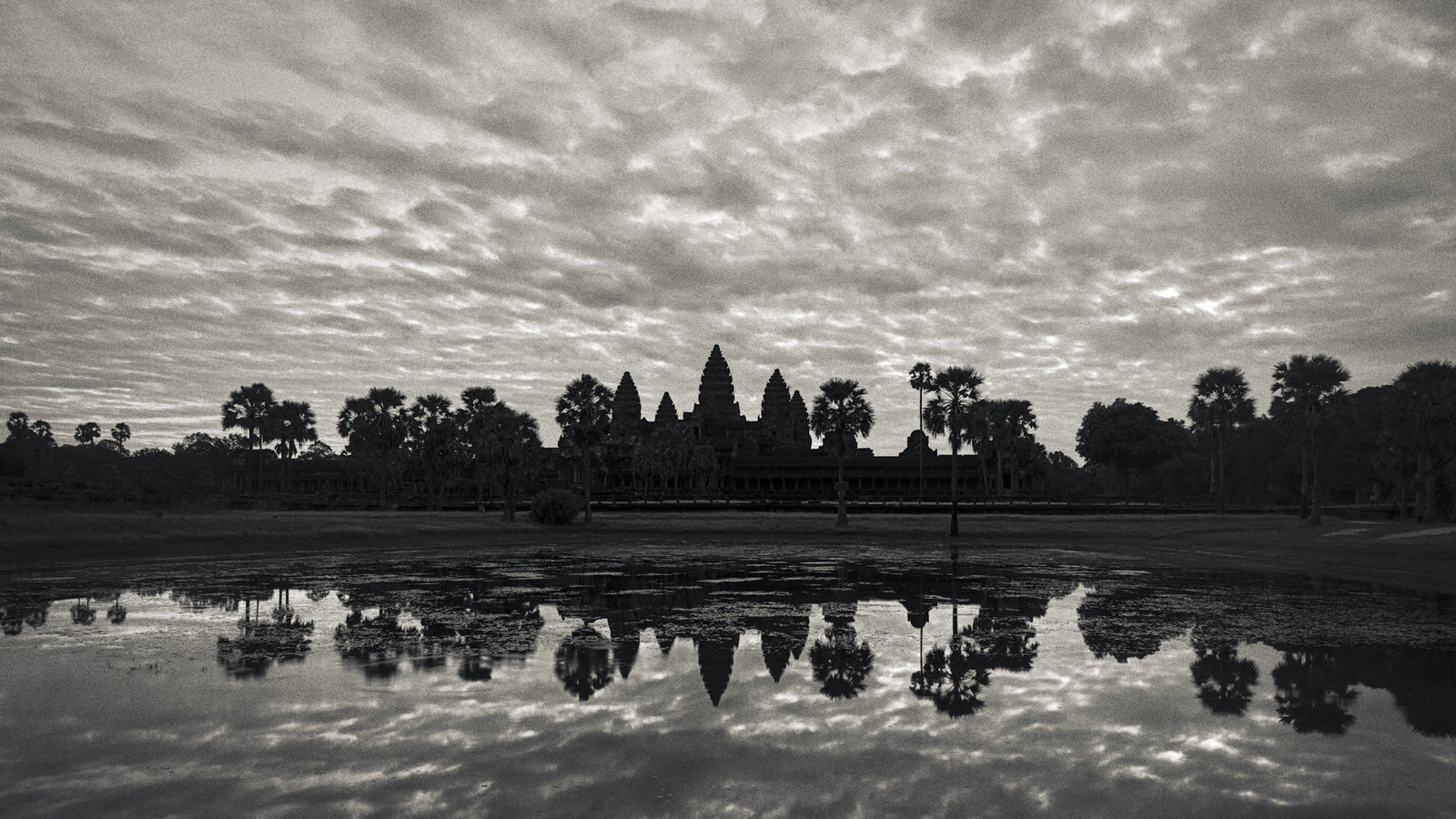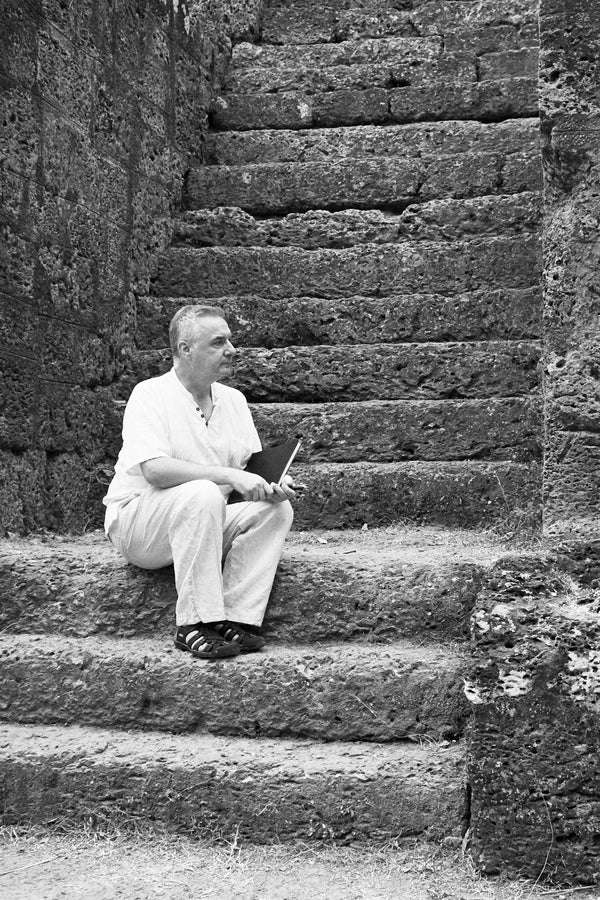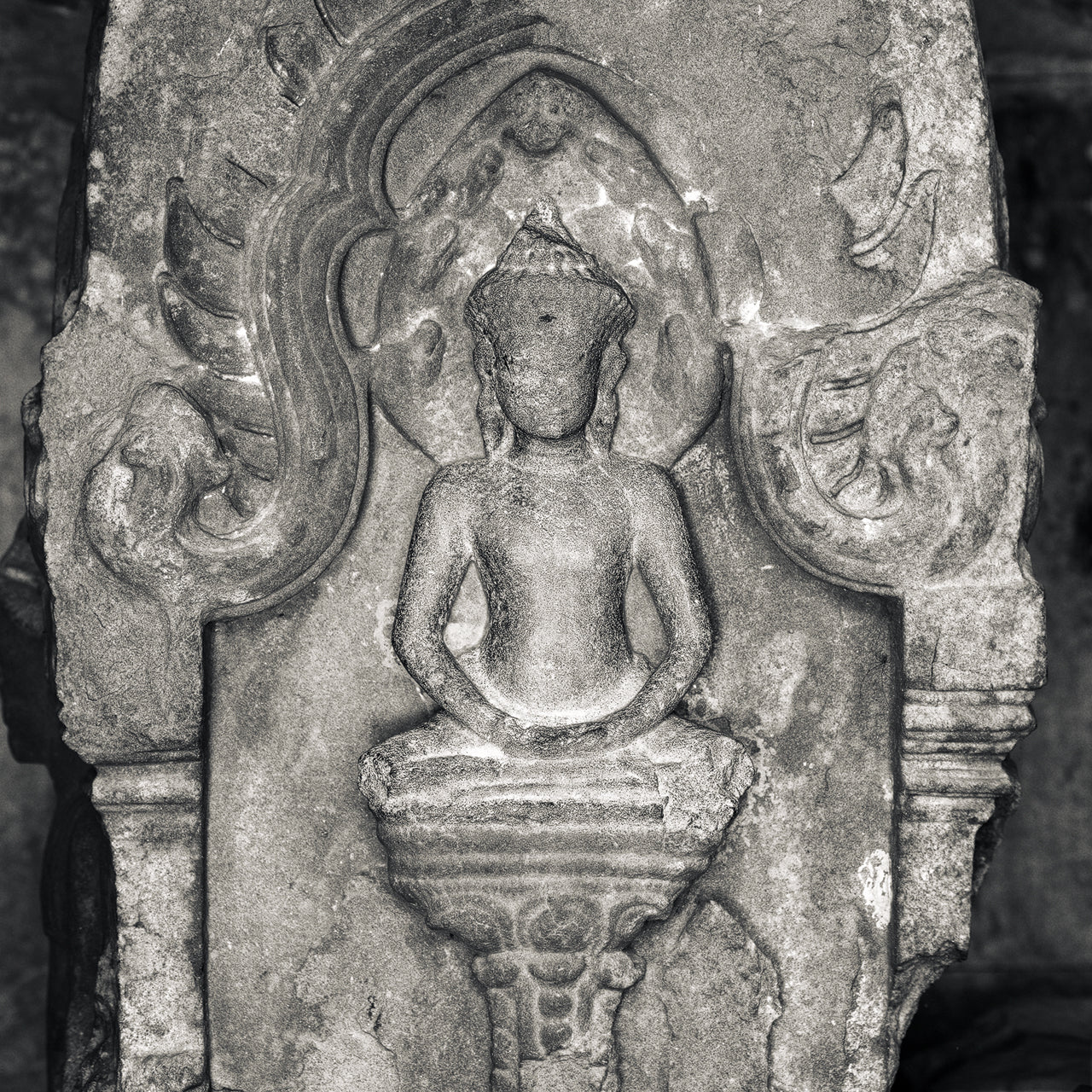Complimentary worldwide shipping on orders over $400 · No import tariffs for most countries
Complimentary worldwide shipping on orders over $400 · No import tariffs for most countries

The Construction of Sacredness at Angkor Wat
Sanctuary of Meaning · Artist’s Journal
by Lucas Varro
—
It is not the stone that makes it sacred,
but what the soul offers in its presence.
—
There are moments, walking beneath the vast galleries of Angkor Wat, when the hush between footsteps feels inhabited. The temple does not speak in sentences—it breathes through shadow and stillness. Its colonnades do not explain themselves, nor do its towers ask for reverence. Yet something in the silence draws the soul into alignment. And then, slowly, like mist rising from ancient loam, one begins to understand: sacredness is not simply found here. It was made—layer by layer, relief by relief, in stone and spirit alike.
Angkor Wat, the “city that is a temple,” rises not only as the world’s largest religious monument, but as an intentional act of invocation. Built in the early twelfth century by King Suryavarman II, it was offered as both an imperial gesture and a cosmic prayer. The king’s posthumous name, Paramavishnuloka—“he who has entered the realm of Vishnu”—is etched upon its bas-reliefs, a final breath in stone. This was to be his celestial resting place, his stairway to the god’s eternal presence. In its grandeur, Angkor Wat declared dominion. But in its form, it became a mandala.
Today, the temple’s once-glorious interior lies bare. The chants of monks echo through emptied chambers. The shrines stand silent. Statues once robed in gold have vanished. Yet the space does not feel abandoned. The gods may no longer wear silk or gleam in precious metals, but their presence lingers in the cadence of pillars, in the way morning light falls across the weathered faces of apsaras, in the breath between the galleries. To walk these corridors is to remember what was once offered—and to feel what still is.
One of the few remaining images stored in the Cruciform Galleries.
We often speak of sacredness as though it were innate, as if certain places are born holy. But here, sacredness was constructed—ritually, visually, architecturally. It was carved into existence with devotion. The narrative reliefs were not mere embellishment. They were scripture in stone, transforming the temple into a cosmogram: a mirror of the divine order.
Inscriptions and traces of devotion reveal a lineage unbroken. Angkor Wat was never lost, as foreign stories suggest. It has always been sacred to the Khmer people. First as a Vaishnavite temple devoted to Vishnu, then—after the fourteenth century—as a Theravāda Buddhist monastery, it remained a centre of pilgrimage and offering. Through centuries of war and drought, its sanctity endured. Even in the seventeenth century, over three hundred sacred images were offered—forty in stone, one hundred and forty cast in precious metal. The devotion did not fade. It changed form.
But what makes a place sacred?
Perhaps it is the convergence of three things: memory, ritual, and orientation toward the divine. Sacredness is not merely presence—it is placement. And nowhere is this more profoundly revealed than in the structure of Angkor Wat itself.
Approached from the west—an anomaly among Hindu temples—the complex unfolds through four concentric enclosures, each a deeper spiral inward, both spatially and spiritually. Crossing the vast moat and sandstone causeway is not simply a passage. It is an initiation. The Western Gopura becomes a cosmic threshold. One does not merely enter Angkor Wat. One is received.
Passing through the Western Gopura one enters a sacred space and a surreal world of imagery.
Within, the galleries unfold like chapters of a living text. Sculpted epics line the walls: the Churning of the Ocean of Milk, the Battle of Lanka, Krishna’s victory. These are not linear tales. They are visual mantras, to be walked, breathed, and remembered. As the pilgrim moves inward, the stories become more distilled—less illustrative, more symbolic—guiding the eye not toward conquest but toward the unmanifest centre. The final ascent to the central sanctuary—Mount Meru itself—is steep, by design. As one climbs, the world falls away.
High above the rain-drenched causeway,
a single swallow circles the spire—
then disappears into silence.
If the outer galleries belong to kings and mortals, the inner sanctum belongs to the Absolute. Here, the stories fall silent. Vishnu is not depicted. He is implied. Light streams through high windows like a revelation. Shadows ripple through the balusters like a hidden prayer. One no longer walks here—one kneels.
The sacredness of Angkor Wat was shaped through a luminous grammar: axial symmetry, proportional geometry, cosmic orientation, metaphysical relief. But it was also shaped by centuries of human offering. Inscriptions speak of gongs and incense, cows and coconuts, gold-leaf and rice. Each gift, however humble, thickened the veil of sanctity. Sacredness, then, is not a principle. It is a participation.
The carvings themselves reflect this living synthesis. Though drawn from Indian myth, their language is Khmer. They do not imitate. The apsaras are not borrowed muses—they are Cambodian, sensual and divine, smiling from the heart of their own soil. The Battle of Kurukshetra panel does not simply recount dharma—it is a portal. These reliefs do not tell stories. They emanate presence. They do not ask to be read. They ask to be entered.
A scene from the Mahabharata on the Battle of Kurukshetra panel.
Even the unfinished pediments and half-formed figures—perhaps halted by the king’s death—add to the mystery. Sacredness does not require completion. Like the worn steps of barefoot pilgrims, or the last glint of gold on a vanished deity’s brow, it is the trace of devotion that sanctifies the stone.
And still today, monks chant beneath its towers. Villagers bring lotus blossoms. Wind stirs the fig leaves. The scaffolds rise and fall, the tourists come and go, but the temple remains. Not in its stone alone, but in the hush before one enters a darkened doorway. In the glimmering silence between breaths.
Angkor Wat is no longer only the house of Vishnu, nor merely the mausoleum of a Khmer king. It is sacred geography. A threshold between realms. A still point in a turning world.
And so we return—not to behold the past, but to walk once more the slow path of offering. To remember that sacredness is never inherited. It is constructed.
And in the hush of morning light, it begins again.
—
Sanctum of Light and Stone
Photographs from Angkor Wat – Spirit of Angkor series by Lucas Varro
At Angkor Wat, the world is not only seen but felt—through corridors brushed by the breath of centuries, through carvings alive with myth and devotion. Built as a cosmic mandala in stone, this vast temple opens like a prayer, unfolding light across the faces of apsaras, warriors, and gods.
Within this sanctified geometry, artist Lucas Varro moves slowly, returning again and again with his large and medium format film cameras—not to document, but to listen. Each image in this collection was made at Angkor Wat and shaped through long exposure, chiaroscuro, and hand-toning, distilling not just what the temple looks like, but what it remembers.
These are photographs born in silence—etched in silver, shaded in reverence. A glance through shadow. A presence at the threshold. A single gesture of grace caught before it faded.
Offered as limited edition, hand-toned archival pigment prints on Hahnemühle Bamboo paper, each work is accompanied by a Collector’s Print Package including poetic writings, curatorial notes, and field reflections from the artist’s dawn pilgrimages.
This collection invites you to walk through Angkor Wat not with your eyes alone—but with your breath, your memory, and your spirit.
Join My Studio Journal
Receive occasional letters from my studio in Siem Reap—offering a glimpse into my creative process, early access to new fine art prints, field notes from the temples of Angkor, exhibition announcements, and reflections on beauty, impermanence, and the spirit of place.
No noise. No clutter. Just quiet inspiration, delivered gently.
Subscribe and stay connected to the unfolding story.

Join My Studio Journal
Receive occasional letters from my studio in Siem Reap—offering a glimpse into my creative process, early access to new fine art prints, field notes from the temples of Angkor, exhibition announcements, and reflections on beauty, impermanence, and the spirit of place.
No noise. No clutter. Just quiet inspiration, delivered gently.
Subscribe and stay connected to the unfolding story.











































